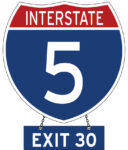 Editor’s Note: This is the 24th chapter in Volume 3 of Editor Emeritus Donald H. Harrison’s 2022 trilogy, “Schlepping and Schmoozing Along the Interstate 5.” All three books as well as others written by Harrison may be purchased from Amazon.com.
Editor’s Note: This is the 24th chapter in Volume 3 of Editor Emeritus Donald H. Harrison’s 2022 trilogy, “Schlepping and Schmoozing Along the Interstate 5.” All three books as well as others written by Harrison may be purchased from Amazon.com.
Schlepping and Schmoozing Along the Interstate 5, Exit 30 (Sorrento Valley Road): Challenger Middle School
From northbound Interstate 5, take Exit 30 (Sorrento Valley Road) to a left turn at Sorrento Valley Boulevard; follow to a right on Camino Santa Fe, then a left at Mira Mesa Blvd., and another left at Parkdale Avenue. The Middle School, on the left, is at 10810 Parkdale Avenue.
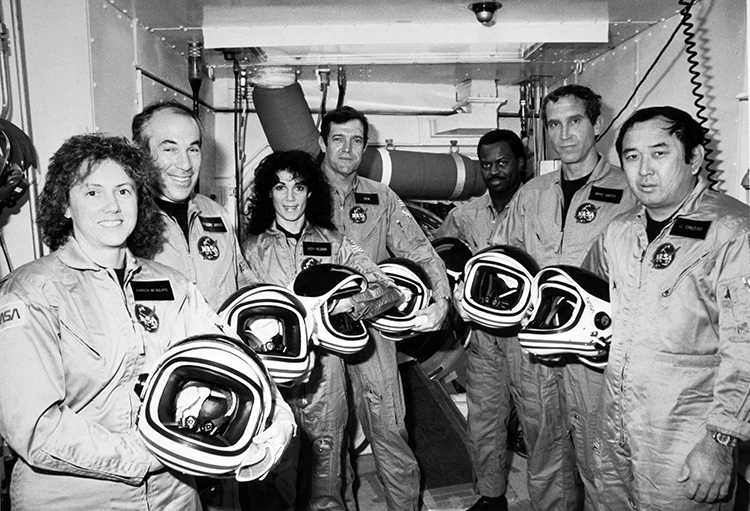
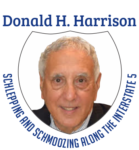 SAN DIEGO – Except in the years of the COVID pandemic, Challenger Middle School has held a commemoration ceremony on January 28th (or as close as possible if that date falls on a weekend) to remember the seven astronauts who died in the explosion of the Challenger spacecraft on January 28, 1986.
SAN DIEGO – Except in the years of the COVID pandemic, Challenger Middle School has held a commemoration ceremony on January 28th (or as close as possible if that date falls on a weekend) to remember the seven astronauts who died in the explosion of the Challenger spacecraft on January 28, 1986.
The seven astronauts reflected American diversity. They included Air Force Lt. Col. Dick Scobee, the spacecraft’s commander; Navy Cmdr. Michael J. Smith; electrical engineer Gregory Jarvis; physicist Ronald McNair, the second African-American in space; and these three “firsts”: Air Force Lt. Col. Ellison Onizuga, the first Japanese-American in space; Christa McAuliffe, the first teacher in space; and Judy Resnik, the first Jewish woman in space.
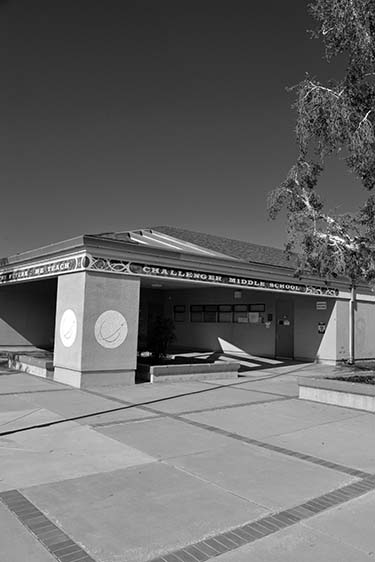
Tamra Winchell, counseling secretary and registrar at Challenger Middle School, said in non-pandemic years, our staff and students usually gather in our Shuttle Court which as a 1/10 scale mosaic of a space shuttle to watch the memorial.” Seven students are each assigned an opportunity to tell about the life of one of the astronauts, and there is a moment of silence and the playing of taps following those presentations.
Preceding the recitation of biographies, the school conducts a patriotic ceremony including the presentation of colors, the Pledge of Allegiance, the playing of the Star Spangled Banner by the school’s advanced band, and an unarmed drill team presentation. In 2019, the poem “High Flight” was read by a student as part of the ceremony. The poem was written by John G. Magee in 1941. U.S. President Ronald Reagan quoted its first and last lines in a televised address to the nation following the Challenger explosion: “Oh! I have slipped the surly bonds of Earth … Put out my hand and touched the face of God.”
In the student tributes, said Winchell, “they tell from the astronauts’ point of view a list of the educational and professional accomplishments, what they intended to do on the mission, and who they were survived by.”
Pictures of the seven astronauts are on display in the school library and, according to Winchell, “we do have a shuttle-O-ring and some other items on display and often pull them out so classes can visit and see original documents such as old newspapers, scrapbooks, and other items about the space shuttle program.” One year, astronaut Ellen Ochoa, whose brother worked at the school district, made a special visit to the campus.
Unfortunately, to Winchell’s knowledge, the middle school never had the opportunity to connect with Encinitas resident Marvin Resnik, a retired optometrist who was the father of Judy Resnik. Marvin Resnik died in 2010 at the age of 90. Although Judy Resnik had been raised in Akron, Ohio, her father and his second wife, Betty, had moved to Encinitas in 1987, the year after the fatal explosion.
Judy Resnik had earned a doctorate in engineering from the University of Maryland in 1977, after she had worked as a design engineer for RCA. According to a fact sheet issued by the National Aeronautics and Space Administration (NASA), “Her projects while with RCA … included circuit design and development of custom integrated circuitry for phased-array radar control systems; specification, project management, and performance evaluation for control system equipment, and engineering support for NASA sounding rocket and telemetry systems programs.”
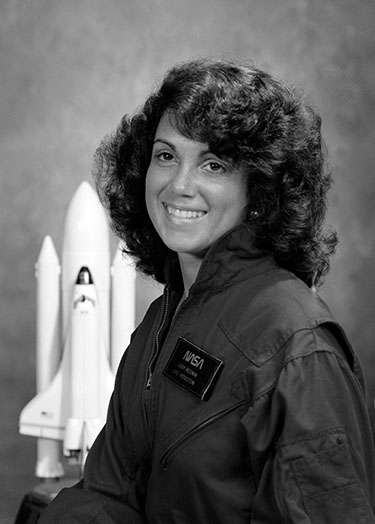
She was, in other words, a professional. Following her training as an astronaut, she participated in 1984 in the seven-day maiden flight of the Orbiter Discovery with fellow astronauts Hank Hartsfeld, Mike Coats, Steve Hawley, Mike Mullane, and Charlie Walker. Her job was to operate the Remote Manipulator System, more popularly known as Discovery’s “robotic arm.”
As only the second woman in space—preceded by astronaut Sally Ride – Resnik was the subject of tremendous media curiosity. After she and other women were selected for the program, a young national television reporter Tom Brokaw in 1981 kept prompting her to talk about gender differences among astronauts, but Resnik declined to be drawn deeply into that line of inquiry.
Q. Brokaw – Once you got into the program, wasn’t there a little bit of resentment, a little bit of male chauvinism, that was demonstrated? It’s a very male, fighter-pilot kind of world that you’re entering, right?
A. Resnik – Not at all. As a matter of fact, I think everyone leaned over backwards to make sure that we were treated as equals.
Q. Brokaw – Is there anything in the space program that women inherently do better than men?
A. Resnik – Not that I can think of. We’re smaller, but that’s about the only thing.
Q. Brokaw – What happens when you meet a man, who is not in the space program, and doesn’t know who you are, and you say, ‘I’m an astronaut.’ Does he say, ‘Ah, you’re too cute to be an astronaut. C’mon lady, you can’t be an astronaut!’
A. Resnik – I tell ‘em I’m an engineer.
Q. Brokaw – Are some men threatened by the fact that you’re an astronaut?
A. Resnik – I don’t know. If they are, they probably are not my friends. All the people I know, it doesn’t bother them. You’re a professional person whatever you do, whether you are an astronaut, a doctor, or a friend.
Q. Brokaw — Are there discussions in Houston about what will happen when men and women go to space the first time together?
A. Resnik – There are not discussions among us.
Brokaw then asked whether it was possible that romantic relations might develop between male and female astronauts.
Resnik replied, “Well, I think from our point of view, we are so used to working together professionally that we look upon each other as professional colleagues on the ground and in orbit or whatever, and we vie it that way period.”
Brokaw tried one more time: “Do you think the time will come when there will be romance out in space?”
Replied Resnik: “How should I know? I couldn’t tell you that.”
When I interviewed Marvin Resnik in 1987, he told me that his daughter Judy had been similarly reticent to talk about being Jewish, or to delineate her feelings about religion.
“She didn’t want to be known as a ‘woman astronaut or as a ‘Jewish astronaut,’” he told me.
“She would say, ‘Of course I’m Jewish, but I don’t practice it. Religion does not enter into my life.’ She was a scientist,” Marvin Resnik commented.
Some Jewish friends who tried to persuade Judy Resnik to speak to their groups complained that she put them off, but the reason was that all public appearances, regardless of the requesting group, had to be cleared by NASA, her father said. He noted that NASA did give approval for speeches to Hadassah and the B’nai Brith.
Marvin and Betty were at the Space Center in Houston observing the launch when the explosion occurred. “I knew right away,” he shuddered. “I saw the explosion and I didn’t see anything like one piece coming down, so I knew.”
Betty commented, “It was going so beautiful. It was a beautiful launch.”
Judy was just 36 when the explosion ended her life and those of her colleagues.
Although the astronaut had said religion played no part of her life as a scientist, her time growing up was a different story.
Marvin, who described himself as a non-believer, nevertheless served for seven years as a High Holy Day cantor at Congregation Beth Israel in Washington, Pennsylvania, where he had lived prior to moving to Encinitas. His explanation: “I like to sing.” A tenor, he said he also enjoyed singing “Ave Maria” at church services.
As a child, Judy attended Hebrew school at Beth El Synagogue in Akron, Ohio; became a bat mitzvah; and continued her Jewish education at a Hebrew high school. While Judy was in junior high, the family dog died, and Judy led two friends to a corner of the living room in her home and chanted the Kaddish. While Judy was still a teenager, Marvin and his first wife, Sarah, divorced. Judy chose to live with her father, whose decision to later marry Betty, then a Baptist, was controversial among older family members. Betty converted to Judaism to prevent Marvin rom being disowned by his parents. Marvin’s father didn’t speak to Betty for two years, until he finally relented.
A brilliant student, Judy was one of only 16 women in the history of the United States to receive a perfect score on her Scholastic Aptitude Test (SAT). While an undergraduate at Carnegie Mellon, she joined Alpha Epsilon Phi, a Jewish sorority.
Her brief marriage to Michael Oldak started under a chuppah in an Orthodox ceremony.
Marvin related that he had an uncle on his mother’s side who was an Orthodox rabbi in Israel, and that when they would visit together, they would debate about religion. The uncle maintained that the five books of the Torah were written by God and given to Moses on Mount Sinai, Marvin took the position that the Torah was written by men. He quoted scientific evidence; his uncle quoted tradition.
Somewhere along the way, Judy decided science to be the winner of this and similar arguments.
*
Donald H. Harrison is editor emeritus of San Diego Jewish World. He may be contacted via donald.harrison@sdjewishworld.com